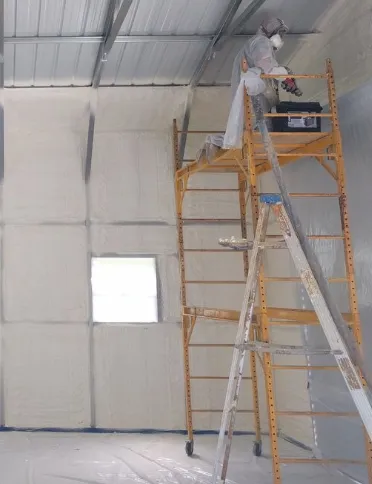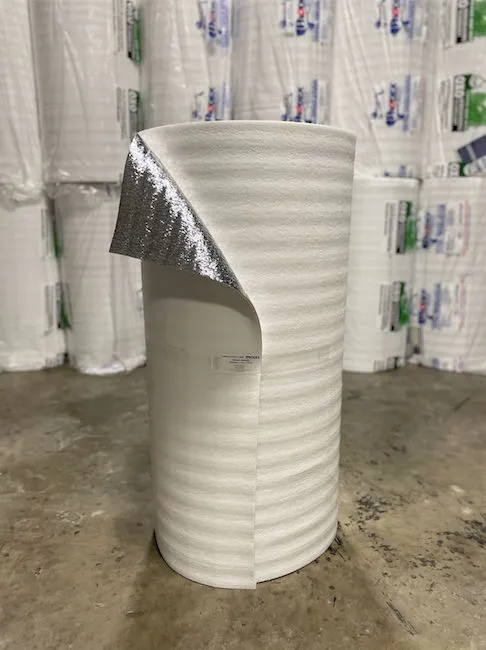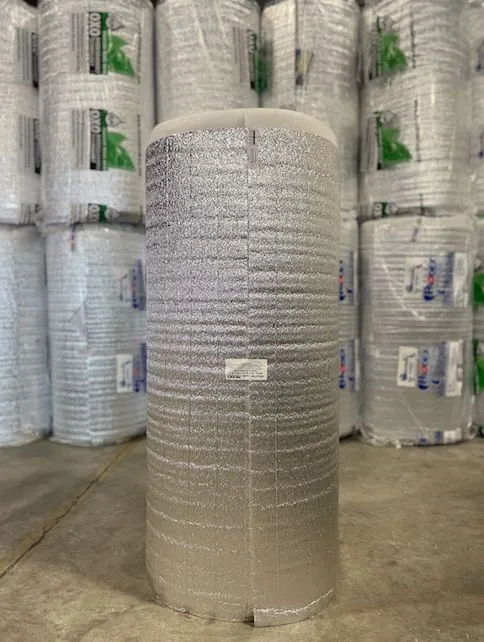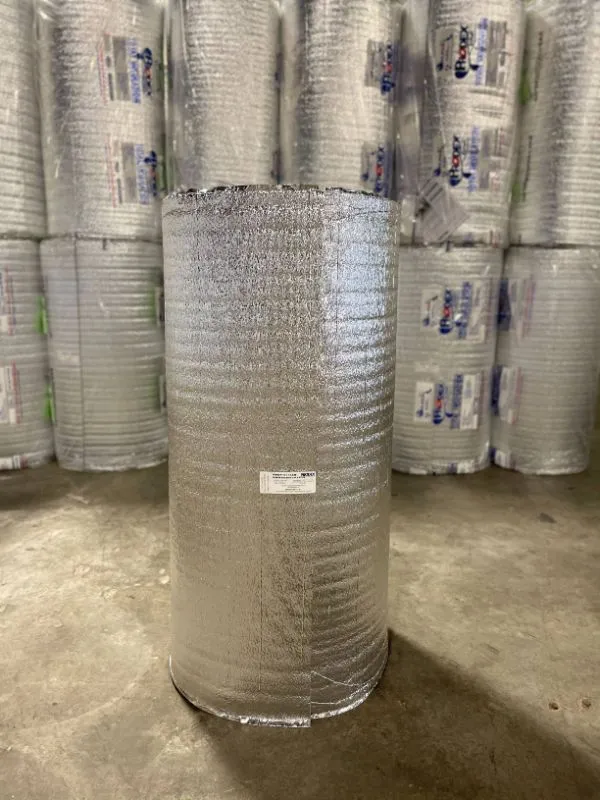Spray Foam Insulation for Metal Buildings and Pole Barns - How to Use It

It’s interesting how more and more contractors decide to build their structures from metal - From small sheds to huge warehouses. Apparently, it’s because structures made of metal are very easy to maintain, are durable and economical. Given the fact that metal has a terrible energy efficiency level when used by itself, it is obvious that it has to be properly insulated in order to be able to provide a decent interior atmosphere. Since spray foam is one of the most popular metal building insulation options, we are going to dive into the reasons why. We're also going to explain how you should use spray foam insulation when dealing with metal building construction.
When we use the term, "metal building", we're referring referring to a buildings with metal framing and sheeting as well as buildings with wood framing and metal sheeting. The later is known as a pole barn.
What is Spray Foam Insulation?
Spray foam insulation is one of the most popular types of insulation, for both residential and commercial buildings. It has many benefits although the costs (which requires professional installation in a metal building) is a little more than other insulations when used in metal buildings. It is a liquid insulation material that can be sprayed on walls, roofs floors, attics, and other hard-to-reach spaces. It keeps its shape and suffers little if any deterioration over time.
There is open-cell and closed-cell spray foam. Even though each one is designed to create an air seal and continuous insulation, there are some differences between them. Closed-cell foam is more durable but also more expensive. It’s typically used for projects like van insulation or pole barn insulation. Closed-cell doesn’t allow water to come through it. Open-cell foam will allow water to pass without allowing its structure to soak the moisture. This helps to prevent mold and mildew growth. Open-cell spray foam is ideal for noise reduction purposes as well, which is why most homeowners use it.
Spray foam insulation kits usually come with two canisters. Each canister contains a specific liquid chemical. The polyurethane foam spray is produced when these two chemicals reach the right terms and conditions. It’s very important that you introduce these chemicals to each other the right way. It is also important to apply the insulation correctly, in order for it to provide the expected energy efficiency. In the last few years, DIY spray foam insulation has become popular for smaller projects. DIY is not recommended for most metal buildings and pole barn projects due to their size. For these type of applications we suggest you hire professionals to do the job.
Is spray foam insulation good for metal buildings?
There is a lot of debate on how good spray insulation for metal buildings actually is.
Energy saving
First and foremost spray foam insulation is effective at improving the energy efficiency in metal walls. Many contractors claim spray foam is the best insulation option for structures built of metal. It delivers an air-tight seal. This regulates the temperature by allowing minimal heat loss. This is especially important regarding roof insulation because the roof is typically the primary location for heat transference in a metal building.
Moisture Barrier
Unlike most other insulation materials, spray foam will completely stop water from entering the interior and creating moisture-prone surroundings. This is significant for two reasons: One, there won’t be an ideal ground for the mold and mildew to grow, and two, the absence of water will prevent corrosion from attacking and destroying the construction of a metal building. Another option that guarantees moisture, vapor, and air barrier is Prodex Total plus which is suitable as pole barn insulation and all sorts of metal buildings.
Cost
When it comes to spray foam insulation cost, is not the most expensive but neither the most affordable. It's pricing is somewhere closer to the higher end. Do-it-yourself spray foam insulation is more economical than if you decide to leave the job to the professionals. In that case, the overall insulation costs will be significantly higher given that applying spray foam takes some time. You may want to consider Prodex Total 10M or 5M insulation. These insulation solutions check all the boxes regarding affordability, quality and energy efficiency.
DIY Spray foam Insulation
We are presuming a huge number of enthusiasts would prefer the do it yourself approach to avoid hiring professionals. If that's what you prefer, here is what you need to know and prepare.
Proper equipment
Applying spray foam requires having a machine to spray it on your desired surfaces. Having spare parts is also important. Having parts will allow you to resume your work quickly after an equipment failure. It’s necessary to regularly clean and maintain your equipment.
Ideal conditions
When it comes to do-it-yourself spray foam insulation the temperature of the room where the canisters are stored has to be right in order for the spray foam to provide maximum performance. Also, the temperature must be ideal when mixing two chemical components together on the job site. The equipment for the insulation application, as well as the pressure under which it sends the foam onto the wall, needs to be perfect, as recommended.
Safety measures
Safety should always come first, and that’s why you have to prepare all the protective gear that’s recommended during the spray foam application process. That includes a full-body suit, protective glasses, headlock, gloves, and air respirator. It is as necessary to protect your skin and your eyes from getting in contact with these chemicals, as it is to prevent inhaling them on site.
Surface evaluation
This step refers to making sure all the walls you are planning to cover with spray foam are ready for the appliance. That means they have to be clean, dry, and free from dirt and grease. Also, in order to prevent unwanted surfaces from being covered with spray foam since it will disperse, you should cover them with a plastic counterpane.
Application
And finally, it is time for you to apply spray foam. If you are still serious about a do it yourself spray foam insulation kit, at least consult with a professional about how you need to do it in order for the insulation to provide maximum energy efficiency. The key is to prepare the canisters right and to spray the walls from the right angle and right distance.
Does spray foam cause rust?
Given that we are talking about an insulation option for metal buildings, some are wondering are there any steel building spray foam insulation condensation issues, or more precisely, is there a chance spray foam will cause rust. In general, the answer is no, but some cases of low-quality foam could lead to acidic action. So it is essential to use nothing but the best products of this kind.
The other problem you may bump into is potential condensation when using closed-cell spray foam. The situation in which this might happen is when it’s extremely cold outside, because this type of spray foam, when applied, comes out at pretty high temperatures. It would be wise to first warm up the space you are planning to insulate.
Spray insulation R-value
We already mentioned that spray foam is one of the best insulation options for both residential and commercial structures built out of metal, and we listed several reasons why. But we didn’t explain that the R-value of this insulation material is probably why most people decide to go with this option. As it turns out, spray foam insulation R-value per inch is among the highest. Sure, it definitely depends on the application, and whether or not you did the insulation job properly, but its overall R-value score is extremely high.
The R-value of open-cell spray foam is R3.5 to R3.6, while the R-value for closed-cell spray foam is R6.5 to R7. It's pretty simple - the higher the density of the spray foam, the higher its R-value. One of the benefits of spray foam is its R-value will remain consistent over time. Unlike fiberglass insulation, which loses R-value as soon as any moisture is introduced, spray foam will stay the way it is as long as the insulation is in its place.
Problems with Spray Foam in Metal Buildings and Pole Barns
- High spray foam insulation cost
- It doesn't prevent radiant heat transfer (the primary source of heat transfer into and out of a building - especially metal buildings and pole barns.
- Do it yourself spray foam insulation can't be done by yourself to retrofit an existing building structure because of the chemicals and processes involved.
- Nearly impossible to use in conjunction with another insulation type.
- With the exception of cementite foams, spray foam insulation can release toxic fumes when it burns.
- According to the U.S Environmental Protection Agency, there is insufficient data to accurately assess the potential for exposures to the toxic and environmentally harmful isocyanides which constitute 50% of the material.
- Can shrink slightly while curing if not applied on a substrate heated to manufacture's recommended temperature.
- Although CFC's are no longer used, many use HCFCs or HFCs as blowing agents. Both are potent greenhouse gases, and HCFCs have some ozone depletion potential.
- Most, such as Polyurethane and Isocyanine insulation, contain hazardous chemicals such as benzene and toluene. These are a potential hazard and environmental concern during ray material production, transport, manufacture and installation.
- Many spray foam insulations are made from petrochemicals and may be a concern for those seeking to reduce the use of fossil fuels and oil.
- Most spray foams require protection from sunlight and solvents.
For Sale - Alternative to Spray Foam Metal Building and Pole Barn Insulation

WHITE 5M Plus: R15.3
Thickness: 5mm (0.2") closed cell polyethylene foam with reflective reinforced foil on one side and plastic white finish film on the other side. Ideal where white finish is preferred.








